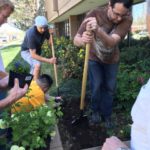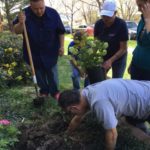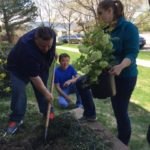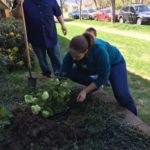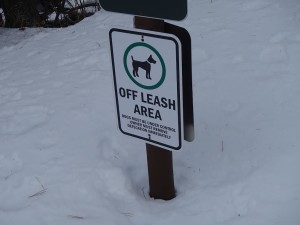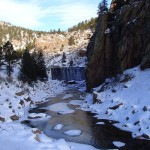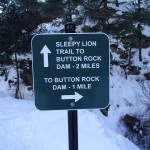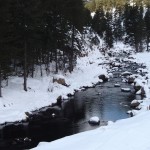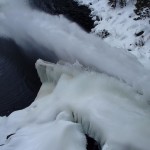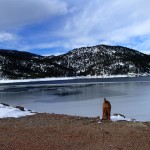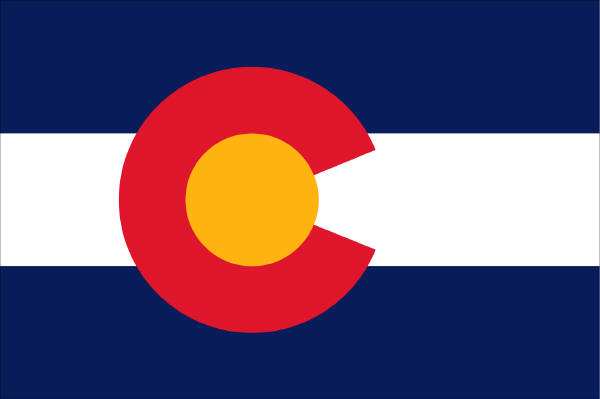LOVE that my employer never forgets Earth Day – one of the million & one reasons I HEART living in Colorado.
Tough to beat last year’s excursion to NOAA (super interesting). This year PS purchased plants & shovels – so we shared a sunny afternoon hour & beautified our entrance stoop. Not too many employers allow you to play in the dirt on Earth Day. Pretty cool, huh?
Unfortunately my mind diverts to global warming, when I think of Earth Day – the horrible man-made disaster we’ve indebted future generations…polluting resources, increasing ground temps +20 degrees until half the US is a virtual Arizona.
My interest in Antarctic iceberg calving is akin to voyeur-viewing a car accident – you can’t help but slow down & stare.
This year’s focus was much closer to home: Durango, in southwest Colorado. Colorado is like the Earth’s playground – evergreen forests, snowy mountain peaks, glacier-fed streams. Last August’s eco-disaster, makes me CRAZY. Polluted, chemically-induced mining water fed local streams in the Four Corners. Most long-term damage only affects the Navajo Nation in western New Mexico…so who cares, right?
Wake up – it’s OUR planet.
Be good to Mother Earth folks, we share space on this beautiful, live-giving planet. If not for you, do it for future generations 🙂
- employer sponsored planting
- not too many employers allow you to play in the dirt on Earth Day 🙂
What The Colorado Waste Water Spill Tells Us About Mining Contamination
By Justin Worland, Time Magazine
PUBLISHED Aug. 10, 2015
Scientists grappled with the consequences of a spill of toxic wastewater on Monday, one day after the Environmental Protection Agency (EPA) reported that an accident had led to 3 million gallons of mining runoff flowing into a river in Colorado used for drinking water. But researchers who study water resources in the region say the spill, while significant on its own, is just the latest example of the much broader problem of water contamination from mining processes.
“In the Rocky Mountain area, acid rock and acid mine drainage is a major water quality problem,” said Diane McKnight, a professor civil, environmental and architectural engineering at the University of Colorado. “This is certainly an unfortunate event, but the impact of acid rock and acid rock drainage is well recognized and understood in Colorado.”
Acid drainage results when water flows through acidic minerals that have been exposed due to mining. Water that contains these minerals in high volumes becomes unsafe for drinking. Colorado alone has hundreds of mines that have created acid drainage—but rarely on the scale of last week’s incident.
Last week’s event was the result of an accident inadvertently caused by EPA workers looking into reports that a mine was leaking contaminated water. During the process, loose material gave way and released millions of gallons of contaminated water, turning the Animas River orange and yielding it unusable for days. Water is still spilling into the river at a rate of 500 gallons per minute, though the EPA has set up a filtering system aimed at removing toxic elements, including copper, lead and manganese, according to regional EPA administrator Shaun McGrath. Still, officials urged local residents to await further tests, which should happen within the next few days, before using the water. The river has been temporarily disconnected from the public water supply.
The consequences of last week’s incident could have lasting repercussions. Events like heavy rain and melting snow that disturb sediment settled at the bottom of the river may release some of the toxic minerals deposited there by the spill. If that happens, local officials will need a game plan to test the water and inform those who may be at risk, said Williams.
The spill has angered local residents, many of whom depend on the river for livestock and tourist businesses. Still, this is hardly the first mining wastewater spill in the area. Largely due to mine pollution, the water doesn’t support a very robust ecosystem, though some organisms manage to live in it. “It’s not correct to say these are lifeless streams,” said McKnight. “There’s certainly bacteria and some algae growing.”
Ultimately, Williams says he hopes the incident raises awareness about the bigger problem of mines polluting waterways throughout the region. The technology exists, Williams says, and efforts by the EPA and other agencies to remediate toxic sites need to be funded fully.
“You hear about pollution, it doesn’t really register,” he said. “Then you see this blob of yellow running down the river.”
Nearly 1 foot of snow falls on Boulder, more expected through morning
The slow-moving winter storm that developed late Sunday had dropped nearly a foot of snow on Boulder by Monday night, with more accumulation expected overnight and Tuesday morning.
National Weather Service forecasters were calling for several inches of additional snow Monday night into Tuesday, with perhaps another inch after 6 a.m. Tuesday.
LOVE LOVE this time of year – brisk morning temps, pink sunrises…and SNOW. Weather ya’ll know is unpredictable – so a Monday/Tuesday storm, while pretty to watch, does not always mean will still be there for weekend play. Colorado high-altitude sunshine burns snow off roads & west-facing trails within a day or 2 (luckily, ground cover stays deep).
Chose an easy hike in Lyons for Saturday – snow increases the difficulty factor. Don’t log in a lot of miles winter hiking…but the landscape/those views are SPECTACULAR. Precip-free drive on 36 toward Estes, hung a left on Longmont Dam Road (County Road 80). Popped the Jeep into 4WD. LOVE LOVE having a vehicle alternative to the Prius 🙂
Relatively late hike start – quarter past 8 – but found ourselves alone this day. Snow.
Leash-free hiking for Sno’ Ro – good day to be dog. Little guy does a good job of staying close on long hikes but always on wildlife alert, better if hiking with another dog.
Followed a plowed trail to the Ranger Station. Unexpectedly easy hike to the dam. Living in the middle of nowhere, new post-retirement goal: Park Ranger 🙂
The St Vrain gurgled from upstream reservoir release. Sucked in high altitude air, wind bit at my cheeks, listened to the river. Quiet. Gotta do this more often, absolutely nothing better.
Deep snow proved a good deterrent for Ro. Sinking to his neck, Ro loped back on trail, glanced behind (checking in on Dad), then greyhound-galloped ahead again. All smiles.
Briefly stopped at Button Rock Dam, water exploding from Ray Price Reservoir into the St Vrain. Thick winter ice formed ’round the pipe release – WOW! Crazy beautiful.
Trudged thru waist-deep snow, switch-backing up remnants of the summer trail ‘til we reached the top. Wind blew strong. Little tree coverage overlooking the Reservoir, which traps snow melt for Longmont & Lyons local water supply. Hugged half the reservoir lip before returning to logging roads, hoping to loop back to the trailhead.
Had earlier averted a herd of deer; Ro picked up their scent but didn’t see them, deep snow further deterred his interest. Hiking down from the Reservoir, 4 deer darted across the road & up the mountain face. No stopping Ro – argh. Thinking the rock face would hold back my pup, I didn’t call him back ‘til he had cleared 500ft+ in elevation. Deer continued to climb. Ro looked around – continue up, or listen to Dad & head down.
Overall – GREAT winter hike. Highly recommended.
Sunday a.m. — Morning run, Ro’s annual vet appointment (yeah, on a Sunday), church, then popped 2 previously prepped dips into the oven for today’s Super Bowl gathering at Ash’s house. Wings, jalapeño poppers, man dip (chili, cream cheese, sharp cheddar) & chicken enchilada dip (whole lotta ingredients).
Two of past 3 years, Denver’s made the Big Game. Long, defensive haul — 24-10 victory for our Broncos. SUPER BOWL 50 CHAMPIONS!
- layered up, getting my snow hike on
- water spray & ice – WOW!
- today’s hike destination: Ray Price Reservoir
Button Rock Dam, Lyons
In between back-to-back-to-back marathon months – been working on the ‘mental’, attending local film festivals & lectures.
Reel Rock 10 – Thursday Sept 17th
Sporting one of the world’s largest climbing communities, no surprise Reek Rock kicks off annually in Boulder. $20 General Admission tickets at historic Chautauqua Auditorium – arrived early & snagged mid-section seats. Series of films with a sense of humor & breathtaking scenery – well received this nite by the locals. While I don’t expect to free climb El Capitan next year, found the festival & its collection of films super entertaining.
Trail Running Film Festival – Tuesday Sept 29th
In only its 3rd year, local trail runners packed in Boulder’s Dairy Center for the Arts – 8 films, 3+ hours of sit time. Sat directly behind & 3 seats across from two guys in the Alaska Mt Marathon flic, titled “3022ft”. Additionally, near half the girls from “She Wanted to Fly” attended tonite (filmed locally here in Boulder).
My fave film, “The Run for Colin”, followed a young man’s quest to set the PCT speed record – Mexico to Canada in under 60 days. Ran 47 miles a day – EVERY day. WOW, left super inspired!
Seriously considering running 5 days, 5 states, 5 marathons in March 2016…seriously 🙂
Jane Goodall – Thursday Oct 1st
Free tickets gone in minutes, crashing the university’s website – count me one of the lucky ones. Life is good 🙂 Impressive living in a community where a lecturing scientist fills an arena & disrupts traffic. #faithinhumanity
To accommodate the public, lecture was moved from Macky Auditorium to Coors Events Center (CU’s basketball arena) – and those tickets went in 2 hours. Largest lecture attendance in CU history – almost 9,000 – crowded into a basketball arena to listen to Dr. Goodall discuss a wide range of environmental topics/our species’ biggest threats: global warming, deforestation, ocean pollutants & use of GMOs in food & modern agriculture (a practice outlawed in Europe).
For Goodall, the legendary primatologist-turned-environmental rock star, who at age 81 travels 300 days a year to every corner of the planet, there is no cause too minor or local when it comes to conservation.
“You’re lucky,” she said toward the end of her 75-minute talk at the University of Colorado’s Coors Events Center. “You live in Boulder, where there really is concern for the environment. Where wonderful things are happening. We want that to spread around the world.”
Goodall’s lecture covered a wide range of topics, from her childhood to her years observing and living among chimpanzees in the Gombe Stream National Park of Tanzania, to her hopes for the future of a planet she believes must rescue itself from total environmental devastation.
Everest – Tuesday, Oct 6th
Heard mixed reviews re: this Fall’s blockbuster film, “Everest”. Based on a true story, knew ahead [that] half the May 10th climbers would not survive. What I didn’t expect however, was how drawn I still am to Everest. Despite this year’s earthquakes & climb season cancellation (super disappointing), found myself mesmerized – almost jealous of the whipping wind, exposed skin & SNOW.
After marathoning St. Jude’s in Memphis – last of 2015 – expect to fill the holiday season with snowy 14er hikes/climbs, tenting & backpacking until my Hawaii run in mid-January.
“The mountains are calling and I must go.” – John Muir
Run Free – The True Story of Caballo Blanco – Thursday, Oct 29th
Ended film festival season attending a newly released documentary on Caballo Blanco. Soon after moving to Boulder, I remember reading about a memorial service held by the local trail running community – but did not understand the significance. Complicated individual. Micah True lived simply among Mexico’s indigenous Tarahumara Indians & spent his last days giving back to these people — promoting an ultra run thru the canyons of northern Mexico, raising funds to support his adopted people. Left tonite feeling, inspired!
American Mountaineering Museum• The feature-length documentary is about ultra-running legend Micah True. Better known as Caballo Blanco – the White Horse – True, was the focal character of Christopher McDougall’s 2009 best-selling book “Born to Run: A Hidden Tribe, Superathletes and the Greatest Race the World Has Never Seen” about the Tarahumara Indians of northern Mexico.
